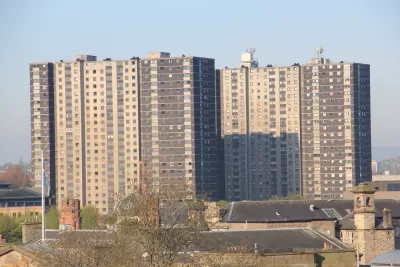Decades of poor urban planning and policy decisions have contributed to "the Glasgow Effect," which has seen higher rates of mortality for Glaswegians compared to similar de-industrialized cities.

Researchers have tied the high rates of mortality for Glaswegians under the age of 65 to decades of poor planning and policy decisions, reports Karin Goodwin of The Guardian. "The Glasgow Effect," as labelled by researchers, has seen a 30 percent higher risk of dying below the age of 65 from the typical causes of cancer and heart disease, as well as the despair diseases of alcoholism and suicide.
The cause of the higher rate of mortality among residents of Glasgow has roots in the policy and planning decisions from the '60s, '70s, and '80s that shifted portions of the population—primarily younger workers and their families—to new towns on the outskirts of the city leaving the poor and elderly in Glasgow's center in high rise housing and peripheral estates.
The schemes of modern Glasgow are often desolate and surrounded by vacant land: 91% of people in Springburn (pdf)– in the north of the city – live 500 metres from vacant or derelict land; Maryhill – in the west – it’s 85%; and in Shettleston – the east – 74%.
This could be having serious effects; earlier this year a statistical analysis of Glasgow (pdf) by Juliana Maantay and Andrew Maroko of City University of New York (CUNY), found a link between poor mental health and the proximity to vacant or derelict link. They also found the effect was lessened when communities had a role in the urban planning process.
Goodwin reports that the tide may be turning in terms of political will to fix the planning mistakes of the past, thanks to new leadership from the Scottish National Party (SNP). However, challenges remain to actually fund the change required to turn around Glasgow's high mortality rate.
FULL STORY: The Glasgow effect: 'We die young here - but you just get on with it'

Trump Administration Could Effectively End Housing Voucher Program
Federal officials are eyeing major cuts to the Section 8 program that helps millions of low-income households pay rent.

Planetizen Federal Action Tracker
A weekly monitor of how Trump’s orders and actions are impacting planners and planning in America.

Ken Jennings Launches Transit Web Series
The Jeopardy champ wants you to ride public transit.

California Invests Additional $5M in Electric School Buses
The state wants to electrify all of its school bus fleets by 2035.

Austin Launches $2M Homelessness Prevention Fund
A new grant program from the city’s Homeless Strategy Office will fund rental assistance and supportive services.

Alabama School Forestry Initiative Brings Trees to Schoolyards
Trees can improve physical and mental health for students and commnity members.
Urban Design for Planners 1: Software Tools
This six-course series explores essential urban design concepts using open source software and equips planners with the tools they need to participate fully in the urban design process.
Planning for Universal Design
Learn the tools for implementing Universal Design in planning regulations.
Ada County Highway District
Clanton & Associates, Inc.
Jessamine County Fiscal Court
Institute for Housing and Urban Development Studies (IHS)
City of Grandview
Harvard GSD Executive Education
Toledo-Lucas County Plan Commissions
Salt Lake City
NYU Wagner Graduate School of Public Service





























